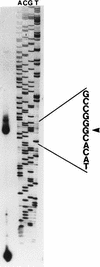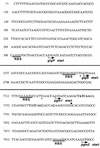Gene organization and transcription analysis of the Agrobacterium tumefaciens glycogen (glg) operon: two transcripts for the single phosphoglucomutase gene
- PMID: 9851999
- PMCID: PMC107758
- DOI: 10.1128/JB.180.24.6557-6564.1998
Gene organization and transcription analysis of the Agrobacterium tumefaciens glycogen (glg) operon: two transcripts for the single phosphoglucomutase gene
Abstract
The gene organization and transcription of the Agrobacterium glg operon differ from those in other bacteria. Agrobacterium tumefaciens A348 contains a 9.1-kb gene cluster harboring genes for glycogen metabolism. The nucleotide sequence and gene organization of a region containing ADP-glucose pyrophosphorylase (glgC), glycogen synthetase (glgA), and phosphoglucomutase (pgm) genes have been previously described (A. Uttaro and R. A. Ugalde, Gene 150:117-122, 1994). In this work we report that the glycogen phosphorylase (glgP) and branching enzyme (glgB) genes are located immediately upstream of this region. The complete nucleotide sequences of the glgP and glgB genes were obtained, and mutants were constructed by targeted insertional mutagenesis with a kanamycin cassette. Enzymatic assays and reverse transcription PCR carried out with the wild type and with glgP and glgB mutants, as well as primer extension experiments and beta-galactosidase fusions, revealed that this region containing five open reading frames (glgPBCA and pgm) is transcribed unidirectionally as a single operon under the control of a promoter located upstream of the glycogen phosphorylase gene (glgP). An alternative transcript was identified starting 168 bp upstream of an internal ATG start codon of the pgm gene, which is translated as a 71-amino-acid-shorter Pgm protein which complements in vivo a pgm mutant. This alternative transcript has a promoter with the motif TATCAAN5G, identified in octopine Ti plasmid as an autoinducible TraR promoter. This promoter is >200 times more efficient in A. tumefaciens than in Escherichia coli, as judged by the level of enzymatic activity of a lacZ-pgm fusion.
Figures





References
-
- Ausubel F M, Brent R, Kingston R E, Moore D D, Seidman J G, Smith J A, Struhl K. Current protocols in molecular biology. Vol. 1. New York, N.Y: Wiley Interscience; 1987.
-
- Becker, A. Unpublished data.
-
- Bullock W O, Fernandez J M, Short J M. XL1-blue: a high efficiency plasmid transforming recA Escherichia coli strain with beta-galactosidase selection. BioTechniques. 1987;5:376–379.
Publication types
MeSH terms
Substances
Associated data
- Actions
LinkOut - more resources
Full Text Sources
Other Literature Sources

